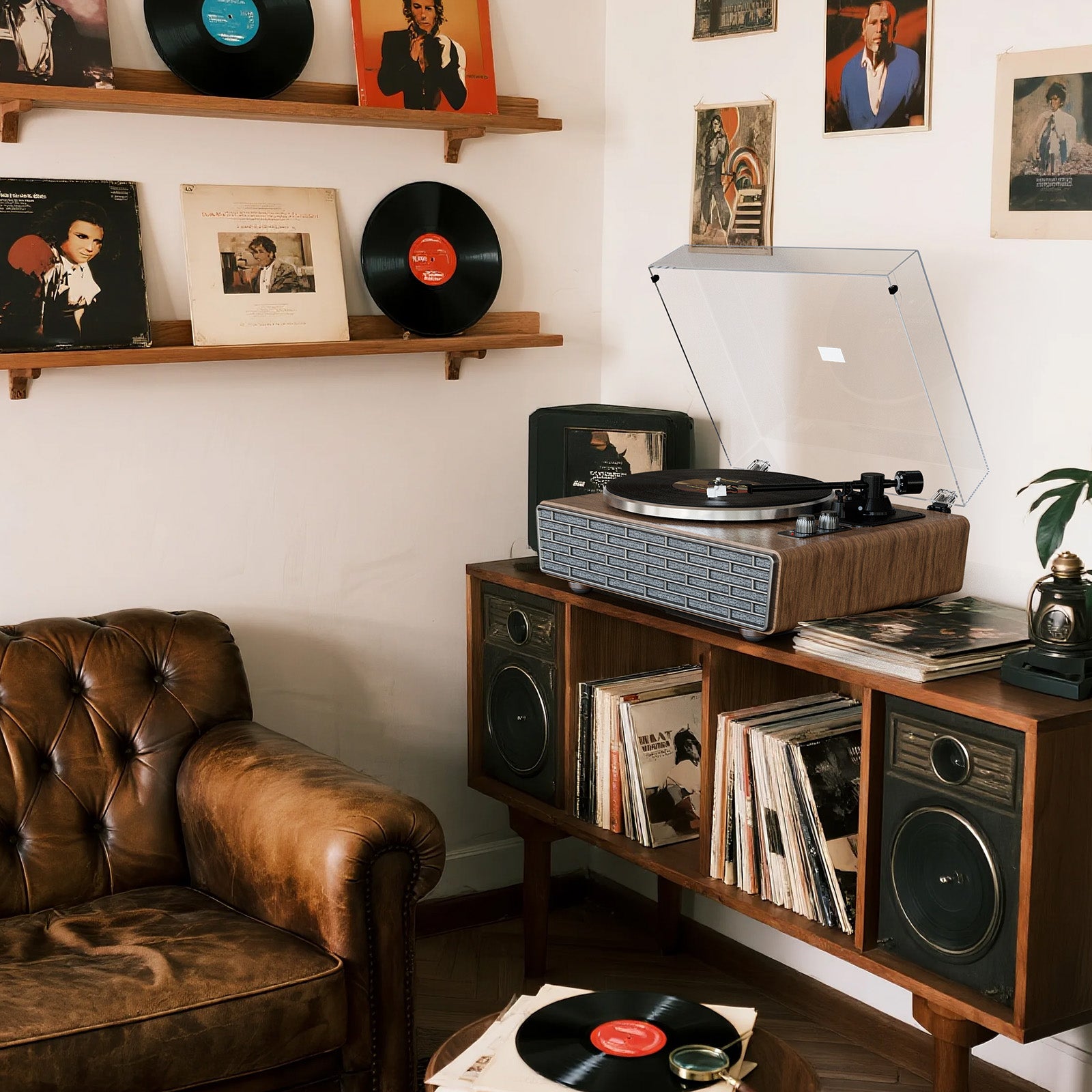In recent years, colored vinyl has taken the music world by storm, transforming the humble LP into a vibrant canvas of swirling hues, translucent tints, and glitter-infused pressings. With vinyl sales surging—over 43 million units sold in the U.S. in 2023, according to the RIAA—colored vinyl accounts for a growing share, captivating both casual listeners and hardcore collectors. But what’s driving this trend? Is colored vinyl purely about aesthetic appeal, or has it become a collectible goldmine? Let’s explore the allure, economics, and cultural impact of this chromatic phenomenon.
The Aesthetic Allure of Colored Vinyl
A Visual Feast
Colored vinyl turns a record into a piece of art. From neon pink to marbled blue, galaxy swirls to glow-in-the-dark green, these pressings elevate album art into a tactile, visual experience. Spinning a translucent red LP on a turntable feels like a performance, with light catching the grooves in mesmerizing ways. Fans often display these records as decor, framing them or propping them on shelves to showcase their beauty.
Enhancing the Listening Experience
The aesthetic of colored vinyl enhances the ritual of listening. Choosing a vibrant LP, admiring its hues, and placing it on the turntable adds intentionality to the act. A 2022 study from the University of Oxford found that physical media like vinyl deepens emotional engagement with music, and colored vinyl amplifies this by making the experience visually immersive.
Artist and Label Creativity
Artists and record labels use colored vinyl to extend their creative vision. Limited-edition pressings often tie into an album’s theme—think Billie Eilish’s Happier Than Ever on sage green vinyl or Taylor Swift’s Folklore in earthy beige. Indie labels experiment with splatter patterns or multi-color blends, making each record a unique artifact. This creativity resonates with fans who see these pressings as an extension of the music itself.
The Collectible Goldmine
Rarity Drives Value
Colored vinyl often comes in limited editions, with pressings as small as 100-1,000 copies. This scarcity fuels demand among collectors. For example, a rare purple pressing of Prince’s Purple Rain from 1984 can fetch $500-$1,000 on secondary markets like Discogs. Similarly, Radiohead’s Kid A on red vinyl, initially a promotional item, has sold for over $2,000. The rarity of specific colors or variants creates a frenzy, with some collectors treating vinyl like fine art or rare coins.

Resale Market Boom
The resale market for colored vinyl is thriving. Platforms like eBay and Discogs report a 30% year-over-year increase in vinyl transactions from 2020 to 2023, with colored pressings commanding premium prices. Limited runs tied to events like Record Store Day—where exclusive colored variants are released—often sell out in minutes and appear online at triple the original price. For instance, a 2023 Record Store Day exclusive of The 1975’s Live with the BBC Philharmonic on clear vinyl retailed for $30 but now lists for $100-$150.
Investment Potential
Some collectors view colored vinyl as an investment. Unlike stocks, vinyl is tangible, and its value often appreciates with time, especially for limited editions from iconic artists. However, not every colored pressing is a goldmine—mass-produced variants, like those from big-box retailers, rarely gain significant value. The key is rarity, condition, and cultural significance. A sealed, colored pressing of Nirvana’s Nevermind from a small 1991 run could be worth thousands, while a common blue variant of a modern pop album might only hold sentimental value.
The Economics of Colored Vinyl
Higher Production Costs
Colored vinyl is more expensive to produce than standard black vinyl. The process involves custom-mixing pigments, which increases manufacturing costs by 10-20%. Smaller batch sizes for limited editions further drive up expenses. These costs are passed to consumers, with colored LPs often retailing for $30-$50 compared to $20-$30 for black vinyl.

Consumer Willingness to Pay
Fans are willing to pay a premium for colored vinyl due to its aesthetic and collectible appeal. A 2023 survey by Vinyl Me, Please found that 68% of vinyl buyers purchased a colored variant in the past year, with 45% citing “visual appeal” and 30% citing “collectibility” as reasons. Record labels capitalize on this, offering multiple color variants to entice fans, sometimes sparking criticism for milking completists.
Scalping and Market Dynamics
The collectible nature of colored vinyl has a downside: scalping. Resellers snatch up limited editions and flip them at exorbitant prices, frustrating fans. Record Store Day exclusives are particularly vulnerable, with some variants reselling for 5-10 times their original cost within hours. This has led to calls for fairer distribution, though the scarcity model continues to drive hype.
Sound Quality: Does Color Affect It?
A common myth is that colored vinyl sounds worse than black vinyl. In truth, modern manufacturing ensures comparable sound quality across colors, as long as the pressing is high-quality. However, certain specialty vinyl—like glow-in-the-dark or glitter-infused—can introduce slight surface noise due to additives. Audiophiles may prefer black vinyl for its purity, but for most listeners, the difference is negligible.
Cultural Impact and Community
Colored vinyl fosters a vibrant collector community. Online forums like Reddit’s r/vinyl and Discogs groups buzz with fans trading tips, showing off hauls, and hunting rare variants. Social media amplifies the trend, with Instagram hashtags like #VinylPorn showcasing stunning colored pressings. This communal aspect makes collecting as much about connection as ownership.
The trend also reflects a broader cultural shift toward physical media in a digital age. As streaming dominates, vinyl offers a tangible, curated experience, and colored vinyl adds a layer of individuality. It’s a rebellion against the intangibility of playlists, appealing to Gen Z and millennials alike.
Aesthetic, Collectible, or Both?
So, is colored vinyl about aesthetic appeal or a collectible goldmine? It’s both, and that’s its magic. The visual allure draws in casual fans, turning records into decor and deepening the listening experience. Meanwhile, rarity and resale value make it a treasure hunt for collectors, with some pressings yielding significant returns. But the true value lies in what colored vinyl represents: a fusion of art, music, and personal expression.
Tips for Collectors
-
Research Variants: Check pressing numbers on Discogs or label websites to gauge rarity.
-
Protect Your Investment: Store vinyl in archival sleeves, away from heat and sunlight (65-70°F is ideal).
-
Focus on Quality: Prioritize well-mastered pressings over gimmicky colors for better sound.
-
Join the Community: Engage on platforms like Reddit or attend Record Store Day for exclusive drops.
Whether you’re spinning a neon pink LP for its beauty or hunting a rare splatter variant for its value, colored vinyl is more than a trend—it’s a cultural movement. Embrace the hues, curate your collection, and let your records tell a colorful story.





Leave a comment
All comments are moderated before being published.
This site is protected by hCaptcha and the hCaptcha Privacy Policy and Terms of Service apply.